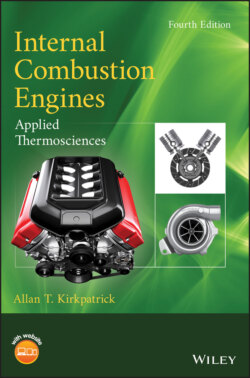Читать книгу Internal Combustion Engines - Allan T. Kirkpatrick - Страница 70
Solution
Оглавление1 The parameters , , and are:
2 and , and are
3 The engine parameters are entered into the FiniteHeatMassLoss.m program as shown below.function [ ] = FiniteHeatMassLoss( ) Gas cycle heat release code with heat and mass transfer thetas = -20; start of heat release (deg) thetad = 40; duration of heat release (deg) Neng = 1910; engine speed (rev/min) r =10; compression ratio b=0.10; bore (m) s=0.0675; stroke (m) gamma = 1.4; gas const Q = 20.; dimensionless heat release ht = 500; heat transfer coefficient (W/m^2-K) T_1 = 300; bottom dead center temperature (K) P_1 = 100; pressure at bdc (kPa) T_w = 360; cylinder wall temp (K) aw = 5; Wiebe parameter a nw = 3; Wiebe exponent n c = 0.8; mass loss coeff ...
The results are presented in Figures 2.21 and 2.22, and representative thermodynamic parameters are compared with the simple energy release computation with no heat or mass loss in Table 2.5. With the heat and mass transfer included, maximum efficiency is reduced from 0.60 to 0.52, and the maximum nondimensional imep is reduced from 13.24 to 11.55.
The cumulative work and heat/mass transfer loss is plotted in Figure 2.23 as a function of crank angle for the optimum case of −20. The cumulative work is initially negative due to the piston compression, and becomes positive on the expansion stroke. The heat transfer loss is very small during compression, indicating a nearly isentropic compression process, and is somewhat linear during the expansion process.
The general dependence of the efficiency and imep on the start of energy release is very similar for both cases, as the optimum start of ignition remains at approximately 20 btdc, and the peak pressure crank angle remains at +11 atdc. Experimentally, the optimum ignition timing, which gives maximum imep is measured on a brake dynamometer, and indicates the maximum brake torque (MBT) for a given throttle position. MBT timing is discussed in more detail in Chapter 13.
Figure 2.21 Thermal efficiency vs. start of energy release for Examples 2.5 and 2.6.
Figure 2.22 Imep vs. start of energy release for Examples 2.5 and 2.6.
Table 2.5 Comparison of Energy Release Models with and without heat/mass transfer loss at = −20 and = 40
| w/o heat & mass loss | w/ heat & mass loss | |
| 87.77 | 85.31 | |
| 11.00 | 11.00 | |
| Net Work/ | 11.91 | 10.39 |
| Efficiency | 0.596 | 0.520 |
| 0.990 | 0.863 | |
| Imep/ | 13.24 | 11.55 |
Figure 2.23 Cumulative work and heat/mass loss for Example 2.6.
